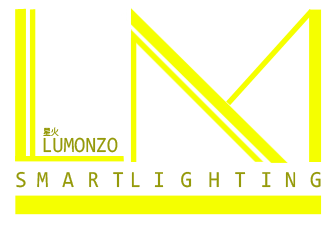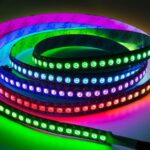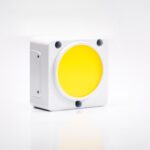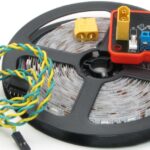
LED Stadium Lights: Transforming Sports Venues with Superior Illumination
Ever wondered how modern stadiums maintain perfect lighting during night games? The answer lies in a technological revolution: LED stadium lights. These powerful and efficient fixtures are rapidly transforming how sports are played and experienced, despite the occasional issue of flickering LED lights.
This in-depth guide delves into the world of LED stadium lights, exploring their benefits, technical aspects, design considerations, and the latest advancements. By the end, you’ll have a comprehensive understanding of this game-changing technology, including how to address and prevent flickering LED lights.
What are LED stadium lights?
LED Stadium Lights are specialized high-intensity lighting systems that utilize Light Emitting Diodes (LEDs) as the primary light source. Unlike traditional lighting options like metal halide lamps, LEDs offer superior energy efficiency, a longer lifespan, and exceptional color rendering.
These lights are typically mounted on high masts or poles strategically positioned around the stadium to illuminate the entire playing field uniformly. Modern LED stadium lights are designed to meet stringent regulations for light levels, uniformity, and spill light control to minimize light pollution.
Advantages of LED Stadium Lights
- Energy Efficiency: LED SSL boasts superior energy efficiency, consuming up to 75% less power than traditional lighting systems. This translates to significant cost savings on electricity bills over the system’s lifespan.
- Enhanced Light Quality: LEDs emit a bright, crisp light with superior color rendering, which improves visibility and creates a more natural playing environment for athletes and a better viewing experience for spectators.
- Reduced Maintenance: LEDs have a significantly longer lifespan (often exceeding 50,000 hours) than traditional lamps, requiring less frequent maintenance and replacement. This minimizes labor costs and downtime.
- Instant-On Functionality: Unlike traditional lamps that require a warm-up period, LED SSL provides instant-on illumination, allowing immediate game restarts and improved flexibility during events.
- Directional Lighting: LED fixtures can be precisely aimed to direct light only onto the playing field, minimizing light spillover and glare for surrounding areas. This promotes energy savings and reduces light pollution.
- Environmentally Friendly: LEDs are free of harmful mercury and other toxins found in traditional lamps, making them a more environmentally friendly lighting solution.
Types of LED Stadium Lights
LED Stadium Lights come in various configurations to cater to the specific needs of different sporting venues. Here’s a breakdown of some common types:
- LED Flood Lights: These powerful, high-intensity fixtures provide broad illumination for large areas. They are often mounted on high masts or poles and are ideal for illuminating entire playing fields.
- LED High Bay Lights: Designed for indoor arenas with high ceilings, these fixtures offer focused illumination and can be suspended from the roof structure.
- LED Wall Packs: These compact and versatile fixtures illuminate walkways, concourses, and other ancillary areas around the stadium.
Design Considerations for LED Stadium Lights
The design of LED stadium lighting systems requires careful planning to ensure optimal performance. Here are some key factors to consider:
Illumination Requirements
Different sports have specific lighting requirements. Factors like ball speed, player visibility, and television broadcast standards need to be considered when designing the lighting system.
Uniformity Ratio
Uniformity refers to the consistency of light levels across the playing field. A well-designed system should have a low uniformity ratio to ensure no dark spots or uneven illumination.
Spill Light Control
Proper design minimizes spill light to reduce light pollution and ensure compliance with regulations. Techniques like light shields and precise beam angles are employed to achieve this.
Maintenance Access
Strategic placement of light fixtures and consideration of maintenance access during the design phase are crucial. This helps ensure efficient cleaning, repairs, or replacements when needed.
Control Systems
Modern LED stadium lighting systems often incorporate sophisticated control systems. These systems allow for dimming, scheduling, and remote management, enabling flexibility and energy optimization.
Advanced Features of LED Stadium Lights
LED stadium lighting technology is constantly evolving, offering new features and functionalities. Here are a few noteworthy advancements:
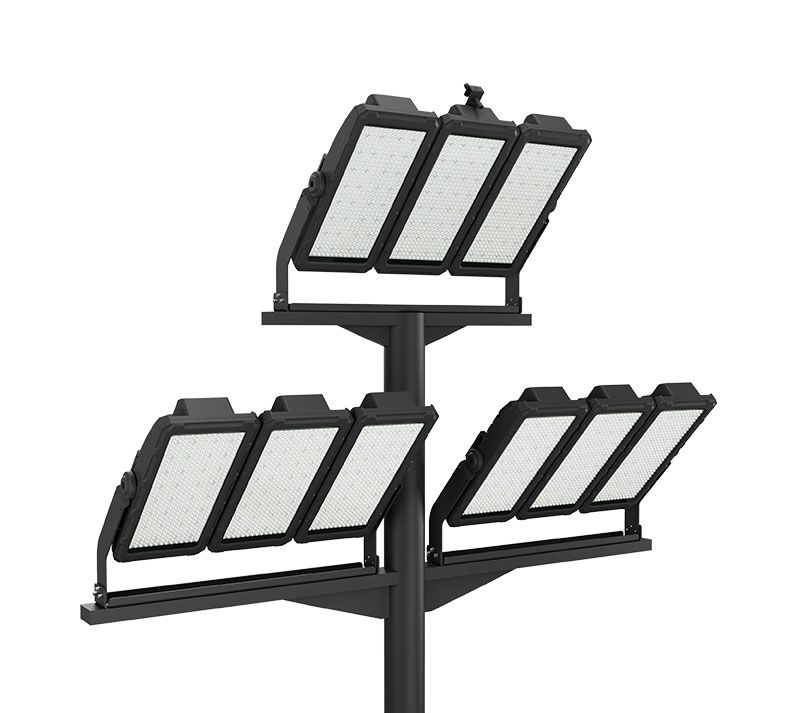
Dynamic Color Control
Some LED systems offer dynamic color control capabilities. This allows stadiums to change the lighting color to create a unique atmosphere for different events or team promotions.
Integration with Building Management Systems
Advanced LED stadium lights can integrate with building management systems for centralized control and monitoring. This facilitates seamless integration with other systems like audio and video for a holistic approach to stadium management.
Cost Considerations for LED Stadium Lights
While the initial investment for LED stadium lights may be higher compared to traditional options, the long-term benefits outweigh the cost. The significant savings on energy bills, reduced maintenance needs, and extended lifespan contribute to a positive return on investment (ROI).
Here are some additional factors to consider when evaluating costs:
- Project size and scale: Larger stadiums with more complex lighting requirements will naturally have higher upfront costs.
- Type of LED fixtures and features: Advanced features like dynamic color control or integration with building management systems will increase the cost.
- Installation and labor costs: The complexity of the installation process can impact labor costs.
Environmental Impact of LED Stadium Lights
Beyond the immediate benefits for stadiums themselves, LED lighting offers a significant positive impact on the environment. Here’s a deeper look:
- Reduced Energy Consumption: As mentioned earlier, LED stadium lights boast superior energy efficiency compared to traditional lighting options. This translates to a significant reduction in overall energy consumption by sports facilities. Lower energy demand translates to less strain on power grids and a reduction in greenhouse gas emissions associated with electricity generation.
- Minimize Light Pollution: Traditional stadium lighting often suffers from light pollution, disrupting natural light cycles and negatively impacting wildlife. LED stadium lights offer superior control over light distribution. Techniques like precise beam angles and light shields minimize spill light, ensuring illumination stays focused on the intended playing field. This reduces light pollution and contributes to a more sustainable nighttime environment.
- Reduced Use of Hazardous Materials: Conventional lighting options often contain harmful materials like mercury. LEDs are free of mercury and other hazardous substances, minimizing the risk of environmental contamination during disposal or accidental breakage. Additionally, LEDs’ longer lifespan reduces the fixtures needed over time, further minimizing waste.
The Future of LED Stadium Lights
Innovation in LED stadium lighting technology is constantly pushing boundaries. Here’s a glimpse into some exciting advancements on the horizon:
- Integration with Smart Technologies: Expect even greater integration of LED stadium lights with intelligent technologies like the Internet of Things (IoT). This will enable real-time monitoring, remote control, and automated adjustments for optimal performance and energy efficiency.
- Enhanced Player Performance and Safety: Future LED lighting systems may incorporate features that optimize lighting conditions for specific sports. This could involve targeted illumination to improve ball visibility for players or dynamic lighting adjustments to reduce glare and eye strain, ultimately enhancing player performance and safety.
- Immersive Lighting Experiences: Imagine synced lighting shows that respond to the game’s action or music during concerts. Advancements in control systems and color-changing capabilities could create immersive lighting experiences that further heighten the excitement and entertainment value for spectators.
By embracing these advancements, LED stadium lights are poised to revolutionize the sports lighting landscape, fostering a more sustainable, dynamic, and visually captivating experience for everyone involved.
Conclusion
LED stadium lights are revolutionizing the way we experience sports. Their energy efficiency, superior light quality, and long lifespan make them a sustainable and cost-effective choice for modern stadiums. With continuous advancements in technology, LED stadium light offer exciting possibilities for the future of sports lighting, promising even greater performance and innovation.
By understanding the benefits, technical aspects, design considerations, and recent advancements in LED stadium light, you can make informed decisions for your sports facility. LED lighting is not just about illuminating the playing field; it’s about creating a vibrant and visually captivating experience for players, spectators, and broadcasters alike.
FAQs
Q: What are the maintenance requirements for LED stadium lights?
LED stadium lights generally require minimal maintenance compared to traditional options. Their extended lifespan reduces the need for frequent replacements. However, routine cleaning of fixtures to remove dust or debris might be necessary to maintain optimal light output. Additionally, periodic inspections are recommended to ensure proper functionality and identify any potential issues early on.
Q: Can LED stadium lights be dimmed?
Yes, many modern LED stadium light systems offer dimming capabilities. This allows for adjustments to light levels based on the specific event or activity. For example, lights can be dimmed during pre-game ceremonies or halftime shows and then brought to full brightness for game play. Dimming also contributes to energy savings by adjusting light levels to specific needs.
Q: What safety considerations are there for LED stadium lights?
LED stadium lights are generally considered a safe lighting solution. They emit minimal heat, reducing the risk of fire hazards. Additionally, unlike some traditional lamps, LEDs are free of harmful materials like mercury. However, during installation and maintenance, it’s important to follow proper safety protocols to avoid electrical hazards while working at heights.
Q: Are there any limitations to using LED stadium lights?
While LED technology offers numerous advantages, there are a few limitations to consider. The initial cost of LED systems can be higher compared to traditional options. However, the long-term savings on energy and maintenance outweigh the upfront investment in most cases. Additionally, the design and installation of LED stadium lighting systems require expertise to ensure optimal performance and compliance with regulations.
Q: Where can I find more information about LED stadium lights?
A: Several resources can provide additional information about LED stadium light. Manufacturers’ websites often showcase their latest products and technical specifications. Industry associations like the National Electrical Manufacturers Association (NEMA) offer resources and guidelines related to sports lighting. Additionally, consulting with a qualified lighting professional can provide tailored advice and recommendations based on your specific needs.
